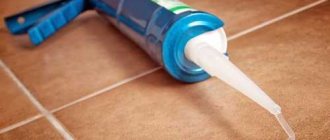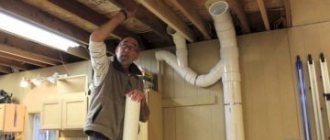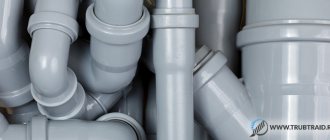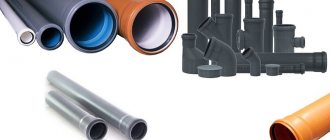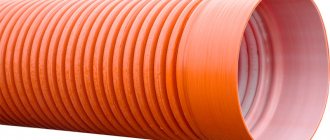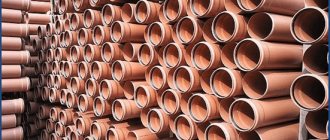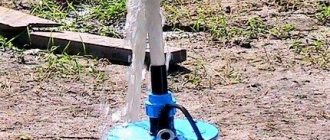One of the most important aspects of home maintenance is drain maintenance. When water supply plastic sewer pipes do not work properly, it is impossible to cook, clean, wash, or wash.
It is important to take care of your drains and know when to call for repairs.
Knowing the worst and best types of sewer pipes and connections, how they can be identified and maintained, and when and whether they need to be repaired or replaced will help with this.
Cast iron pipes for sewerage
When asked what types of sewer pipes there are, the answer is: either copper or plastic (polyvinyl chloride (PVC) and acrylonitrile butadiene styrene (ABS)). In pre-1960 homes, other types of drainage structures (DWVs) made of iron or steel are sometimes found.
It is cast iron that is most often used in vertical drains of that era, sometimes found in horizontal and ventilation ones. Although the material is durable, it will rust over time. A drain service technician will replace the rusted links with plastic ones.
Homes built in the 1950s feature galvanized steel, which is relatively durable but rarely lasts more than five decades. As soon as corrosion takes its toll, it is better to replace galvanized steel with plastic.
Practice
Theory is good; however, most readers will find practical advice much more useful. We figured out what features different pipes have; but which ones are better when installing domestic sewerage?
For myself, I formulated the answer like this:
- In an apartment or private house, you can safely use gray PVC pipes. Their noise is compensated by laying them in the basement or through technical rooms. Where this is not possible, collapsible boxes are constructed from gypsum plasterboard or wall panels;
The sewer drain in my house is located in the basement.
- For external installation, you can safely use an orange pipe made of the same PVC. In areas with increased loads, it is placed in a closed reinforced concrete tray. This solution guarantees the integrity of the sewer system under any load.
Types of plastic sewer pipes
Acrylonitrile butadiene styrene (ABS)
Since about 1975, plastic pipes have become an inexpensive and easy-to-repair alternative to metal materials. ABS plastic, or "black piping", was the first to be used in residential architecture.
Despite its stainless surface, this material did not remain durable for long. In some places, ABS is prohibited in new home construction.
Polyvinyl chloride (PVC)
The leading choice in residential gutter lines for the last four decades. PVC is a light-colored, very durable plastic that is resistant to the elements and is more durable than other piping materials.
Available in several types: 40 mm and 80 mm, as well as chlorinated polyvinyl chloride (CPVC). Their usage is as follows:
- 40 mm is used for laying drainage under houses;
- 80mm is controversial due to its inability to withstand high water temperatures, however the material is used in some cold supply lines;
- CPVC is able to withstand heat and is therefore used for internal piping.
Asbestos cement pipes
Asbestos-cement pipes are durable, which is why sewer pipelines are made from them. Cement and asbestos fiber are not destroyed by rot, acids or corrosion.
Advantages:
cheapness, durability, resistance to acids, alkalis, aggressive media, strength, ease of installation, resistance to blockages. Disadvantages:
fragility, instability to mechanical influences, harm to people and the environment. Given their low cost and durability, asbestos cement pipes are not the best option. They are more difficult to transport and install than polyplastic - the weight is higher than that of polymers.
Also, asbestos cement crumbles along the edges, which is why the seal is compromised with incorrect or poor-quality connections. Camo dangerous, especially for internal connections: environmental damage of asbestos concrete. Asbestos releases carcinogens, it is dangerous to work with it, and to live near it.
Standard sizes of sewer pipes
A common operational problem is figuring out the sizes. Determining which one is needed for your home or project is a frustrating and difficult process. If you have not used this product before, here are three important sizing details:
- outer diameter does not match size;
- PVC schedule is important;
- some pipes are not compatible.
Pipe sizes are named by measuring the internal diameter (hole), not the external one. When measured, it will be larger than the actual size.
The outside of the toilet drain pipe will always be larger than indicated in the name due to the thickness of the “walls”.
If you are not sure about the characteristics, read the labeling. Each plumbing manufacturer labels its products differently, but the scheme is approximately the same - the diameter, temperature threshold and type are indicated.
Range of diameters of pipes of different types
Underground drainage and polyethylene sewer pipes should be available in a range of diameters and for any application. High-strength PVC pipes with a smooth surface prevent the roots of nearby plants and trees from taking root.
Brands Hunter, Brett Martin, ULTRA3 produce sewer pipe diameters for toilets of different sizes. For more severe operating conditions there are options from 200 to 400 mm.
Polyethylene sewer pipes are used for all types of commercial and agricultural purposes, creating drainage systems and drainage or attenuation systems.
For both perforated and non-perforated coils, 25m and 50m lengths are available in 5 diameters, allowing installers to partially control the water flow rate. Drainage structures come in diameters of 60 mm, 80 mm, 100 mm, 160 mm and 200 mm.
Double wall outdoor water drain pipes have a smooth interior surface for water flow and a rough exterior surface to protect against any damage that may occur on site.
If the inside is smooth, there will be no accumulation of silt. Perforated or non-perforated to allow wicking and absorption, double-walled plastic pipes come in large diameters: 150mm, 225mm, 300mm, 375mm, 450mm and 600mm.
Cast iron underground pipes for domestic sewerage are silent, 100% recyclable, non-flammable and have high tensile strength.
In some cases, installation is a must due to its durability and minimal maintenance.
Cast iron drain pipes and bends, where the diameter of the sewer pipe for a private house is from 100 mm to 400 mm, cost less than you think.
Features of installation work
If the installation of a sewer pipeline is carried out independently, which is quite realistic, then it is important to take into account some features of the work. These features include:
- Plastic products, depending on cast iron, are thinner and more fragile, so to provide additional protection it is recommended to place them in special boxes, casings or foam shells.
- When a pipe is connected to a socket, you need to chamfer the outside of the product that will be placed inside the socket. In this case, it is imperative to remove burrs in the internal cavity of the pipe to prevent the formation of blockages.
- To simplify the process of connecting two pipes, they resort to the use of lubricants: Solidol, Glycerin or Litol.
- The neck of the pipe is fixed with a clamp, since O-rings are not able to provide the necessary rigidity of the structure.
- Fixation of sewer pipelines in the room with clamps is carried out every 50 cm.
- It is recommended to install the external pipeline at a depth of at least 50-70 cm. The presence of a slope of such a pipeline will eliminate the occurrence of stagnation and clogging of the pipe.
- For increased loads, it is recommended to use corrugated sewer pipelines.
When connecting sewer pipelines, it is recommended to additionally coat the joints with waterproof sealants. This will eliminate not only the occurrence of leaks, but also an unpleasant odor in the room.
Plastic sewer products are characterized by efficiency, unlike their cast iron counterparts. If there is a need to repair the sewer system or build a new drain, then it is recommended to give preference to a new type of material for the construction - plastic.
What type of drainage piping is best?
- Easiest to repair: CPVC
Chlorinated Polyvinyl Chloride is PVC with added chlorine, making CPVC suitable for running tap water. Plastic plumbing pipes stand the test for decades. When repairs are needed, damaged parts can be removed with a handsaw and refilled with adhesives, making CPVC the easiest home sewer pipe and fitting material when it comes to maintenance.
On the other hand, it is the worst from an environmental point of view. Not only is it not recyclable, its production involves a high level of pollutants. Strong toxic chemicals are used in the formation of the links, although plumbing pipes and PVC sewer adapters do not pose a threat to the quality of tap water.
- The safest material: polypropylene (PPR)
Throughout Europe, homeowners over the past 30 years have been pleased with the new product - polypropylene.
The plastic material is known to be durable and water-safe and is advertised as an environmentally friendly product.
Polypropylene is much more expensive. Installation is a complex process that requires industrial tools.
- Optimal for sewerage: PVC
Since the 1950s it has become the material of choice for wastewater piping. It is a hard white plastic that is easily identified by markings indicating its diameter, temperature threshold and type.
PVC is a favorite material among builders due to its rust-resistant texture and infinite durability.
However, it is not suitable for incoming water flow - use is limited to toilet and sewer lines due to the lack of heat resistance of the plastic.
Polyethylene
The use of polyethylene pipes when arranging an internal drainage system can be observed extremely rarely. But, if installers or the homeowner decide to use this particular material, then you should look for either cross-linked or low-density polyethylene. The second option is able to withstand temperatures within +400C, so it is used only for cold drainage systems.
Among the advantages of the material it is worth noting
- High threshold of strength characteristics, as well as flexibility;
- Resistance to corrosive processes;
- No silting;
- Low weight;
- Ability to withstand pressure drops in the system;
- Long service life;
- Easy installation;
- Price.
All of the above advantages are also inherent in other materials. But here are some of the disadvantages:
- Lack of resistance to ultraviolet radiation. This feature will not allow the use of parts when installing an external wastewater disposal system;
- The material allows oxygen to pass through, damaging metal parts of the system. Naturally. Manufacturers coat the pipes with a special mixture. However, it does not provide 100% protection. And during the installation work you should be extremely careful so as not to cause damage;
- Rapid surface wear (abrasion).
You may also like: Sewer pipe diameters - table and dimensions
Advantages of PVC material
- Durable and lightweight: abrasion resistance, light weight, good mechanical strength are important technical advantages when used in construction.
- Easy to Customize: PVC can be cut, formed, welded and quickly joined into a variety of designs.
- Resistance: resistant to weathering, rotting, chemical degradation, impact and abrasion.
- Profitability: financially competitive, because its cost increases due to durability, service life, low maintenance requirements.
- Environmental impact: Thermal insulation improves energy efficiency of structures, prevents leakage, smooth surfaces reduce fluid pumping costs. PVC products require relatively less energy and resource use throughout production, as well as emissions for transportation and installation.
- Safety: PVC is a non-toxic, inert polymer that meets international safety and health standards.
Polypropylene
Today, polypropylene products are actively used not only when installing plastic sewage systems, but also when equipping a heating system. It is important to understand that the properties of this material directly depend on the structure.
When carrying out internal drainage, you can use parts made from ethylene and propylene copolymer. Such polymer pipes for sewerage are marked PPR. They can withstand up to +700C. Parts marked PPs will be even more reliable; they can withstand up to +950C without problems, as well as short-term exposure to higher temperatures.
The advantages of the material in question are as follows
- Long service life;
- High anti-corrosion characteristics and resistance to salts, alkalis and acids;
- High strength characteristics;
- Light weight;
- No problems with silting due to the absolutely smooth surface inside the part;
- Resistance to temperature changes, allowing the installation of a drainage system under any conditions without deformation;
- Easy installation without a welding machine;
- Relatively low cost;
- Products labeled PPs fall into the non-flammable category.
Types of PVC products
The only drawback is deformation when constantly exposed to negative temperatures. Banal insulation of the pipeline or installation of compensators will help to cope with this phenomenon.
Fittings for external and internal sewerage
Water can penetrate into any structure, so effective drainage is as important as the sewerage system itself. Poor drainage can cause damage to fertile soil, agricultural systems, residential areas and commercial properties.
Fittings are sewerage products with a smooth internal and external surface. They are made for a variety of purposes: assembly by welding and external reinforcement, injection molding in steel molds, implementation of the finished product due to thermal deformation of elements of suitable length.
Their nominal ring stiffness and standard aspect ratio must comply with the technical specifications. Fittings for cast iron sewer pipes are coated inside and outside with epoxy powder paint in various shades. Check out the photos below.

